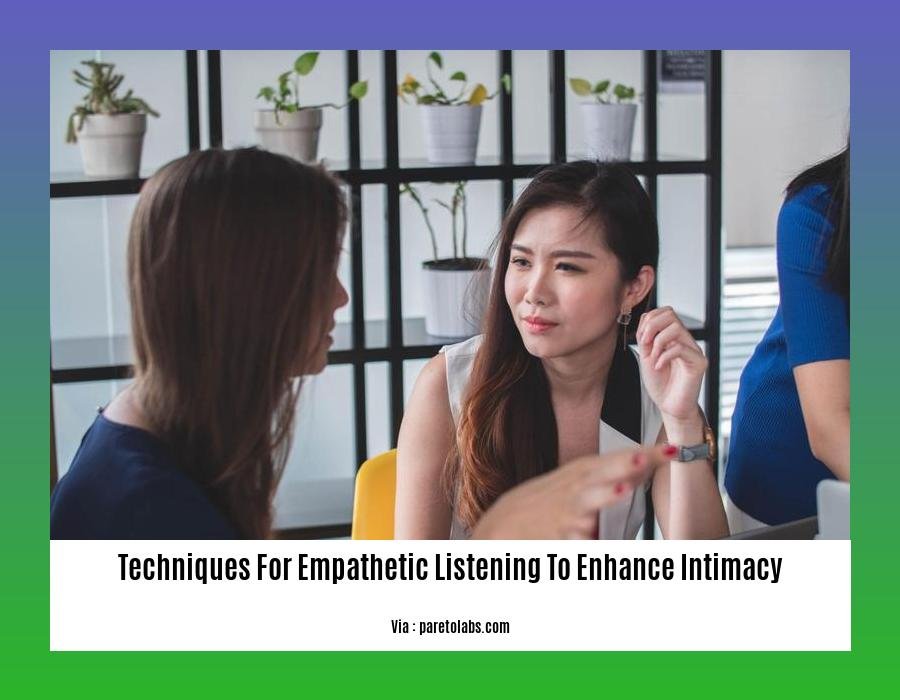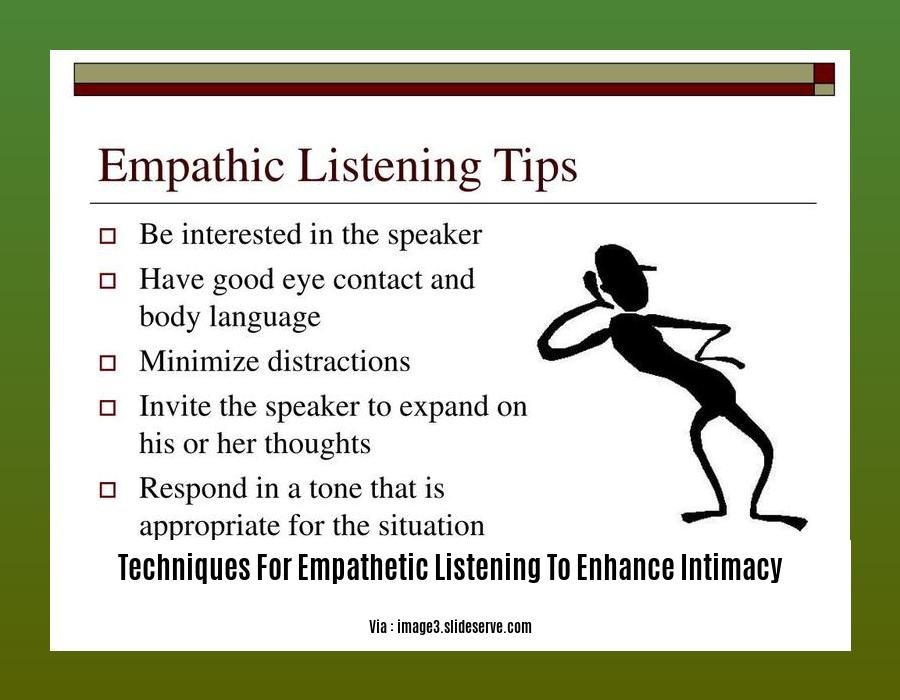Embark on a journey to enhance intimacy through the art of empathetic listening. Join us as we delve into the transformative power of “Techniques for Empathetic Listening to Enhance Intimacy.”
Key Takeaways:

- Share and validate emotions.
- Respond positively.
- Listen attentively and eliminate distractions.
- Communicate empathy and understanding.
- Ask clarifying questions.
- Avoid defensiveness and judgment.
- Quiet your mind and listen actively.
- Allow ample time for the speaker to express themselves.
- Acknowledge and identify emotions.
Techniques for Empathetic Listening to Enhance Intimacy
Empathetic listening is a powerful tool that can help you build deep and fulfilling relationships. It involves not just hearing what your partner says, but also understanding their feelings and perspectives. When you listen with empathy, you create a safe space for your partner to share their thoughts and emotions, which can lead to greater intimacy and connection.
There are several techniques you can use to improve your empathetic listening skills:
- Give your full attention. When your partner is talking to you, make sure you’re really listening to what they have to say. Avoid distractions like your phone or the TV, and make eye contact with them.
- Suspend judgment. It’s important to be able to listen to your partner without judging them. Try to understand their perspective, even if you don’t agree with it.
- Reflect back what you’ve heard. Once your partner has finished speaking, reflect back what you’ve heard to make sure you understand them correctly. This helps them feel heard and understood.
- Ask clarifying questions. If you’re not sure about something your partner has said, ask clarifying questions. This shows that you’re interested in what they have to say and that you want to understand them.
- Avoid giving advice. Sometimes, your partner just needs to vent. Avoid giving advice unless they specifically ask for it. Instead, just listen and offer your support.
By practicing these techniques, you can improve your empathetic listening skills and build stronger, more intimate relationships.
Benefits of Empathetic Listening
- Builds trust: When you listen to your partner with empathy, they feel safe and understood. This can help to build trust and connection.
- Enhances communication: Empathetic listening can help to improve communication between partners. When you understand your partner’s feelings and perspectives, you can better communicate your own needs and wants.
- Deepens intimacy: Empathetic listening can help to deepen intimacy between partners. When you listen to your partner with empathy, you create a stronger bond and a deeper understanding of each other.
Unleash the power of active listening skills for better relationship communication and transform your romantic bond. Engage fully in conversations with your partner by becoming an engaged listener who truly understands their needs and perspectives. Employ active listening strategies that validate their emotions and build a deep sense of connection.
Develop Nonverbal Communication Skills
Key Takeaways:
- Focus on body language: Use open and inviting postures, gestures, and facial expressions to convey interest.
- Maintain eye contact: Establish a connection and convey attention.
- Use facial expressions: Smile, nod, or raise your eyebrows to indicate understanding or encouragement.
- Pay attention to posture: Sit or stand upright, uncrossed arms, to signal receptiveness.
- Respect personal space: Be mindful of the distance between you and the other person.
Nonverbal communication is a powerful tool for building trust and connection. By developing nonverbal communication skills, you can enhance your listening abilities and create a more fulfilling and intimate relationship.
Tips for Effective Nonverbal Communication:
- Maintain a relaxed and open posture. This signals that you are approachable and receptive.
- Make eye contact regularly. This shows that you are engaged and interested in what the other person is saying.
- Use appropriate facial expressions. A smile can convey warmth and friendliness, while a nod can indicate understanding.
- Be mindful of your gestures. Avoid fidgeting or making distracting movements that could break the connection.
- Respect the other person’s personal space. Stand or sit at a comfortable distance, and avoid touching them unless they initiate it.
By incorporating these tips into your communication, you can greatly enhance your nonverbal communication skills and build stronger, more intimate relationships.
Citation:
Practice Reflective Listening
Practice Reflective Listening empowers individuals to connect deeply with others through empathetic communication. Its techniques foster intimacy and understanding, enhancing relationships and overall well-being.
Benefits of Reflective Listening:
- Improved understanding
- Enhanced rapport
- Demonstrated empathy
- Opportunities for clarification
- Deeper connections
Techniques for Reflective Listening:
- Mirroring: Subtly mirroring nonverbal cues to convey empathy and rapport.
- Parroting: Repeating the speaker’s words to demonstrate active listening.
Key Takeaways:
- Cognitive Empathy: Understanding the speaker’s thoughts and perspectives.
- Emotional Empathy: Experiencing the speaker’s emotions.
- Compassionate Empathy: Understanding, feeling, and actively supporting the speaker.
Additional Considerations:
- Quiet your mind to fully focus on the speaker.
- Listen openly without interrupting.
- Pay attention to both verbal and nonverbal cues.
Citation:
Incorporate Empathy into Your Communication
Empathetic listening is like a magical bridge that connects hearts and fosters intimacy. By incorporating empathy into your communication, you unlock the power to truly connect with others, building stronger relationships and creating a more harmonious world.
Key Takeaways:
- Quiet your mind: Clear your thoughts and focus solely on the person speaking.
- Give undivided attention: Show genuine interest by making them the center of your attention.
- Listen actively: Engage with your ears and heart, comprehending both words and emotions.
- Avoid judgment: Listen without prejudice or assumptions, allowing for open expression.
- Use non-verbal cues: Nodding, leaning in, and maintaining eye contact indicate understanding.
Steps to Incorporate Empathy into Your Communication:
-
Clear Your Thoughts: Before engaging in conversation, take a moment to quiet your mind and remove any distractions that may hinder your focus.
-
Focus on the Speaker: Give your undivided attention to the person speaking. Make them feel like they are the most important person in the room.
-
Listen Actively: Engage with your full attention. Show genuine interest by nodding, leaning in, and maintaining eye contact. Avoid interrupting or changing the subject.
-
Avoid Judgment: Listen without prejudice or assumptions. Allow the speaker to fully express their thoughts and feelings without feeling judged or criticized.
-
Use Nonverbal Cues: Nonverbal cues are powerful tools for expressing empathy. Nodding, leaning in, and maintaining eye contact all indicate that you are engaged and understanding.
Benefits of Incorporating Empathy into Your Communication:
| Benefit | Explanation |
|---|---|
| Builds Trust: Creates a safe and supportive environment where individuals feel comfortable sharing their thoughts and feelings. | |
| Enhances Communication: Improves understanding and communication between partners, leading to more meaningful conversations. | |
| Deepens Intimacy: Fosters stronger bonds and mutual understanding, creating a sense of closeness and connection. |
Relevant URL Source:
- Empathic Listening: The Key to Deeper Connections











